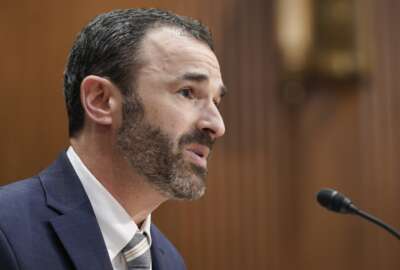Earthquake reinforces telework benefits
Thousands of office workers didn\'t have to deal with road construction and confusion about building closures after Tuesday\'s earthquake in Washington — because...
wfedstaff | June 4, 2015 10:22 am
By Emily Kopp
Reporter
Federal News Radio
Tuesday’s earthquake led to clogged parking lots and long commutes home for many federal workers, followed by uncertainty about whether they should go into work Wednesday morning.
But at least one agency that heavily utilizes telework said it avoided the chaos.
Danette Campbell, the senior advisor on telework at the Patent and Trademark Office, said as many as 6,400 scientists, engineers and attorneys — or roughly two thirds of the agency’s staff — thankfully work outside the office on any given day.
“Had all 10,000 employees been on the USPTO campus in Alexandria, it would’ve been a nightmare going home,” Campbell said Wednesday during a panel discussion on telework hosted by FedScoop in Washington.
Campbell said the PTO has had a telework policy for 14 years. Other agencies, however, are just beginning to let employees work from home.
The Telework Enhancement Act of 2010 required agencies to establish policies, designate a senior official to manage telework implementation and notify employees of their eligibility to work outside the office by June 7.
But two months after that deadline, the law doesn’t seem to be the quick kick in the pants that some had hoped for.
“I get to see who’s buying laptops and desktops,” said Nigel Ballard, federal marketing director at the computer-chip maker, Intel. And, he said he got the impression that the status quo hasn’t changed because, “You can’t telework with a desktop.”
While complying with the new law was easy for agencies with telework policies already in place, others had to start from scratch.
“They are just now waking up to the possibilities of telework,” said Office of Personnel Management chief of staff Justin Johnson.
He said OPM is encouraging managers and employees to discuss how their agencies’ new telework policies could apply to their situation. The law requires the parties to put an agreement in writing. OPM also is rolling out this fall a revised training course for employees.
But a recent survey cited “control-freak” managers as reluctant to embrace telework.
Johnson said some staff members also have been slow to embrace the new options. Employee unions, in particular, are wary that managers will dole out telework rights to favorite employees rather than imposing an across-the-board policy for everyone under their supervision.
“If you’ve got 50 employees who do the same thing, then generally their opportunity to telework should be similar,” Johnson said. “It shouldn’t be based on an existing friendly relationship with one employee over another. That’s where agencies get themselves into trouble.”
In the best situations, managers view telework as an essential business tool rather than a favor to staff. Campbell said the Patent and Trademark Office examiners who gave up their office space to work at home have saved the agency $19.8 million in real estate costs.
That’s not to dismiss the idea of telework as a perk. OPM’s most recent survey indicates it’s a bonus, even when workers choose not to take advantage of it.
“Telework has become a proxy for trust,” said Johnson. “If I know I can do my work from anywhere and I’m not allowed to, I feel disrespected and I’m going to leave.”
Johnson added smart telework policies can help agencies retain employees and recruit new workers. The next OPM report will be the first test of whether agencies are applying the new telework law to their advantage. It’s due to Congress next summer.
RELATED STORIES:
Why aren’t more people teleworking?
OPM: Tips to meet June 7 telework deadline
Are federal managers getting the telework training they need?
(Copyright 2011 by Federal News Radio. All Rights Reserved.)
Copyright © 2025 Federal News Network. All rights reserved. This website is not intended for users located within the European Economic Area.





